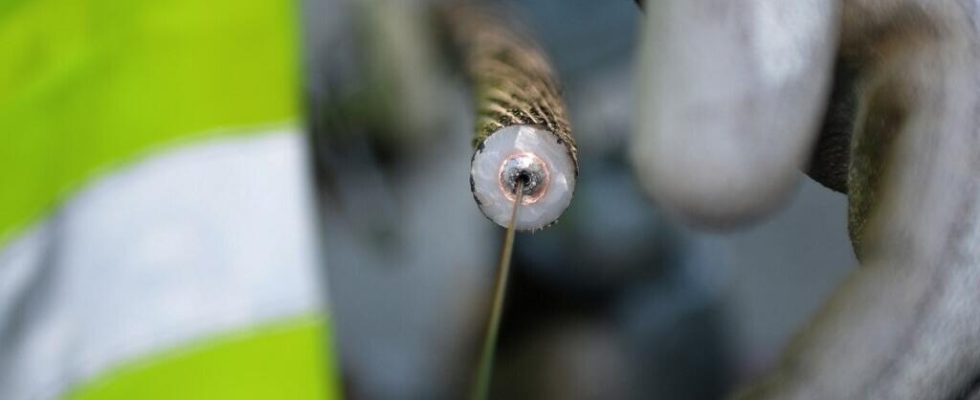Part of the African continent was deprived of internet access on Thursday March 14, after the tearing of four of the five submarine cables which connect West Africa to the global network. If the various operators reacted quickly to redirect their flows and restore the network, repairing the cables could take several weeks.
4 mins
After internet disruptions that affected many West African countries like Côte d’Ivoire, which was the most impacted, Liberia, Burkina Faso, Guinea and Ghana, the situation has gradually returned to normal. Of the five submarine cables linking this part of the continent to Internet, four were damaged, including those of two of the largest operators, Orange and MTN. In most cases, this type of incident is due to the cables being torn off by ship anchors, the activity of fishing boats or by underwater ground movements.
Read alsoAn ocean of cables, the web highways in question
The outages mainly concern the West Africa Cable System, Africa Coast to Europe, SAT-3 and MainOne cables, all tens of thousands of kilometers long, serving several countries along the West African coast and connecting to Europe , notably in Spain, the United Kingdom and France.
Traffic redirected to restore the network
To restore internet access as quickly as possible, service providers reacted quickly. In the hours following the outage, the South African operator MTN assured that “ operations » were in progress for “ redirect traffic through alternative routes to the network “. Same thing for Orange who immediately said “ mobilized to find traffic rerouting solutions and connect countries isolated by other routes “.
By redirecting flows, internet operators were able to quickly stabilize the situation and restore satisfactory network access for most of the countries affected by this outage. MTN, for example, affirmed this Monday March 19 that it had “ successfully restored operations, recovering over three terabits per second of capacity » over its entire coverage area. “ Throughout this period, we have prioritized service restoration by quickly activating new cables to increase interconnectivity and establish alternative routes, strengthening the resilience of our network », welcomed the South African operator.
As of 19 March 2024, Bayobab Group, a subsidiary of MTN Group, has successfully restored its operations and recovered over 3 Terabits per second (Tbps) of capacity across our footprint.
Read more: https://t.co/CbXzXmsapQ#DoingGoodTogether— MTN Group (@MTNGroup) March 19, 2024
Locate the incident to repair
Their repair is now a priority for operators to avoid network saturation, but it is a complex and tedious task. “ You must start by precisely locating the cut, explains Stéphane Lelux, the president of telecom firm Tactis at the RFI microphone. Then, a specialized vessel must be sent to the site, which will have to precisely detect the position of the cables. That already takes a few days: three, four or even five days maximum “.
These specific ships are what are called cable ships. They are designed to install garden hose-sized cables on the ocean floor, but also to repair them. Up to 2,000 meters deep, underwater robots are responsible for recovering each end of the damaged cables, but beyond 2,000 meters, the situation becomes complicated. In this case, ” we work the old-fashioned way, with a grappling hook that we leave lying around at the bottom. We raise it to bring the cable back on board and once it is raised we can see if we hit it correctly. », explained Didier Dillard, CEO of Orange Marine, one of a dozen companies in the world capable of repairing submarine cables, to the newspaper The New Republic in 2023.
An operation which can take several weeks »
The time that repairs can take therefore varies greatly. Once the cables are reassembled, “ we cut them cleanly and we redo the welds on these cables which we join with a waterproof sleeve which will then be put back at the bottom of the sea. There, we have four cables therefore four operations to be carried out. It may take several weeks », Estimates Stéphane Lelux. The optical fiber being very fragile, the operation to resolder the fibers together can take between 15 and 20 hours for each joint. Work carried out by very specific personnel specially trained for this type of intervention.
Nearly 99% of intercontinental internet traffic is provided by submarine cables, their importance is therefore capital, particularly for Africa. The continent is very dependent on submarine cables, including for continental connections. I think that the lessons to be learned from all these incidents, which will unfortunately continue, are first of all to diversify the routes and strengthen the interconnections between countries. », concludes Stéphane Lelux.
Read alsoEurope monitors its sea cables: “The risk of sabotage exists”
